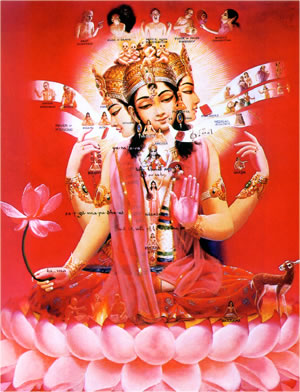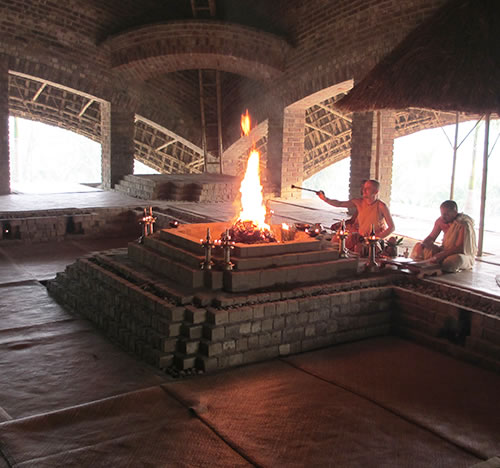How Long is a Year in
Vimsottari Mahadasa?
Page 3
1 2 3 4 5 6
We can easily see that Rishis such as Parasara Muni were not confused as to how long a year was in regard to calculating the year for Mahadasa. Astronomy is a branch of astrology (gola-khandha) and the astronomical year is based on the motion of the Sun as explained above by Maitreya Rishi. Thus, it strongly suggests that the Rishis used a standard astronomical year based on the motion of the Sun (365.25 days) for calculating the Mahadasa. Below we have reproduced a table from Bharatiya Jyotish Sastra (BJS-History of Indian Astronomy) published by the Government of India which clearly indicates that the Rishis accepted the Sun as the standard for measuring a year.
Length of the year according to different Vedic astronomical texts (BJS vol. 2, p. 13).
| days | ghati | pala | vipala | prativipala | |
|---|---|---|---|---|---|
| Vedanga Jyotisa | 366 | ||||
| Pitamaha Siddhanta | 365 | 21 | 25 | ||
| Pulisa Siddhanta | 365 | 15 | 30 | ||
| Surya Siddhanta | 365 | 15 | 31 | 30 | |
| Romaka Siddhanta | 365 | 14 | 48 | ||
| 1st Arya Siddhanta | 365 | 15 | 31 | 15 | |
| Brahmagupta Siddhanta | 365 | 15 | 30 | 22 | 30 |
| 2nd Arya Siddhanta | 365 | 15 | 31 | 17 | 06 |
[1 ghati = 24 minutes = 60 pala, 1 pala = 60 vipala, 1 vipala = 60 prativipala]
In previous times, say even 300-500 years ago, to be an expert astrologer in India required that the aspirant have mastered several difficult pre-requisites namely: Sanskrit, mathematics (ganitha) and astronomy (gola) before they could study astrology. This screening process meant that only the leading intellectual giants, the top 5 percentile, could even proceed to the study of astrology. Is it any wonder that the predictions of such brilliant intellects seldom went wrong? Unfortunately, with the introduction of astronomical tables, and then easily available published ephemerides, and now computer programs, has actually been a set back for the dignity of Vedic Astrology. (Also Western Astrology. It has been stated by scholars of Western Astrology, such as Robert Hand, that astrology declined in the West when ease of mathematical calculation made it accessible to greater numbers of lower intellect.)
Practically speaking, there is no longer any intellectual rigor among those beginning the study of Vedic Astrology. Astrology software requires little in the matter of brain power to master, thus the average intellectual acuity and cultural knowledge of those who want to practice Vedic Astrology has dropped precipitously. Is it any wonder then that today astrological predictions seldom come true? Not only is intellectual acuity and rigor rarely found but by the lack of training in basic astronomy, calendar making and kalpana (rituals) these students are not even sufficiently armed to figure out for themselves whether a astrological year should be 360 or 365 days long! And, thus fall into confusion about how long a year should be. Because of this ignorance truly needless controversies such as this one keep cropping up when the next batch of untrained students show up. No one who had training in mathematics and spherical astronomy, as was required in the old days, would suggest using a 360 day year as the basis for astrological calculations. Astrology and astronomy are inextricably tied together, you cannot have one without the other, and a 360 day year makes absolutely no astronomical sense.
Is there more than one type of year,
if so what are they?
Were there any other kinds of years beside the solar year mentioned in the Vedas? There were five astronomical measures of time: Savana (sacrificial), lunar, solar, sidereal and Jovian. Of these the Vedas only describe the first three, the other two are only in astronomical texts.
A solar year is the length of time from one vernal equinox to the next. Alternatively it could be the time between successive uttarayanas (Winter solstice) or daksinayanas (Summer Solstice) of the Sun. The vernal equinox (first day of spring) is the midpoint between uttarayana and daksinayanas. These solar movements define the seasons. The solar year is thus the interval of the cycle of the seasons.
The sidereal year as of 1989 was 365.256363 days and is used for astronomical calculations. The word "sidereal" means star based, thus a sidereal year is the length of time it takes the Sun to return to the same position relative to the stars. It is slightly different than the solar year, about 20 minutes or so. The difference is caused by the precession of the Sun, a tiny motion of the Sun along the ecliptic due to wobbling (nutation) of the Earth (heliocentric perspective). It is only about 51 seconds of arc/year but after hundreds of years it adds up. The accumulated amount is known as the ayanamsa, an important entity in Vedic astrology.
The Jovian year, is based on the motion of Jupiter. It is called the Brhaspati Samvatsara and is related to the length of time it takes Jupiter to go through all the signs of the zodiac (about 12 years). Five such cycles equal 60 years which is it self a cycle the first year of which is called Prabhava, etc. There are various ways of measuring the Jovian year. The original way was to call the time between successive heliacal rising of Jupiter as a Jovian year. Heliacal rising of a planet means that as the Sun gets close to a planet it becomes invisible to our vision for some time. Then as the Sun moves on the planet again becomes visible, this time when it first becomes visible is the heliacal rising of the planet. The interval between heliacal risings of Jupiter is about 400 days. Later, different systems came in vogue in North and South India for determining the Brhaspati Samvatsara. The Brhaspati Samvatsara is important in mundane astrology and its use is outlined in texts such as Brhat Samhita by Varaha Mihira (he uses the original heliacal rising definition).
The Savana year has its origin in the Soma-yajna. We shall discuss it and the Lunar year more later.
What is meant by reference to
360 and 365 day/year?
This whole controversy has arisen in modern times in relation to the calculation of Vimsottari Mahadasa. It is thus assumed that there are two options:
1. to measure a year by 360 days
2. to measure a year by 365 days.
We must carefully note here that day means the normal Vedic civil day measured from sunrise to sunrise.
In the Vedas and Puranas there is mention of a 360 day year the following quotes speak of this:
The wheel (of time) having twelve spokes revolve round the heavens, but it does not wear out. Oh Agni! 720 pairs of sons ride this wheel. Rg Veda Samhita 1.164.22
Twelve spoke boards, one wheel, three navels. Who understands these? In these are 360 Shankus (rods) put in like pegs which do not get loosened. Rg Veda Samhita 1.164.48
A year has 360 days, a year has 720 days and nights together. Aitareya Brahmana 7.17
BJS vol. 1, pp.17-20.
We note that a 360 day year is not a natural division of time but rather artificial, we shall presently see that this 360 day years serves a very explicit purpose and not for general usage. The 360 day year doesn't refer to the length of a solar year (365.25 days) or lunar year (360 tithis, about 354.36 solar days). The year of 360 days is called a Savana year and used strictly for sacrificial purposes particularly for the Soma-yajna as explained in the following quote from Dikshit's Bharatiya Jyotisha Sastra (BJS):
The period between two consecutive sunrises is known as a Savana day. The term 'Savana' has its origin in the 'Soma sacrifice.' In a soma-sacrifice the soma juice has three savanas, that is, it is offered three times during the period of a 'day and night.' [The term 'three navels' mentioned in the previous cryptic Rg Veda verse seems to refer to this.] This idea is expressed by Madhavacarya in his work Kala Madhava as follows:
"Therefore, that which pertains to savana is savana, that which pertains to candra (moon) is candra and that which pertains to surya (sun) is saura."
The Soma-sacrifice which is completed in one day of 24 hours is known as 'aha' in the Vedas (and it appears that the day also used to be known as 'aha'). A group of six such 'aha's is known as a 'shadaha' and five such shadahas make a 'masa' or month. Several such shadahas and masas are required to be observed in a samvatsara-satra, annual sacrifice, and all of them together make 360 days. (BJS vol. 1, p. 22.)
Thus we see that the Vedas and Puranas do refer to a year of 360 days but this was closely related to Vedic sacrifices and not for civil or astrological use. It is also not stated whether intercalary days were added to the end of the Savana year to make it coincide with seasons as is done with the Lunar year, or if the Savana years ran consecutively. We have discovered that the Savana year of 360 is related to the Soma-yajna therefore how did it get confused in astrological calculations? The answer to this is simple: ignorance of how people kept calendars in pre-British India. This will become clear shortly. But first let us deal with the next point:

